BMO1102 - Management and Organization: Theories in Global Business
VerifiedAdded on 2023/06/13
|9
|1976
|490
Essay
AI Summary
This essay provides an in-depth analysis of the challenges faced by Australian businesses in the process of globalization. It highlights the difficulties in management practices, such as adapting to change, managing a diverse workforce, and navigating economic fluctuations. The essay also examines the stages of globalization, including exporting, cooperative contracts, strategic alliances, and wholly-owned affiliates, discussing their strengths and weaknesses. Furthermore, it delves into the impact of implementing management theories and organizational behavior on decision-making within Australian businesses, emphasizing the importance of cultural understanding and strategic vision for success in the global market. The study uses phase model and evaluates the emergence of strategic innovation on various business industries of Australia. The essay concludes by underscoring the need for product strategic diversity to attract global customers and address the challenges posed by linguistic, cultural, and psychological barriers.
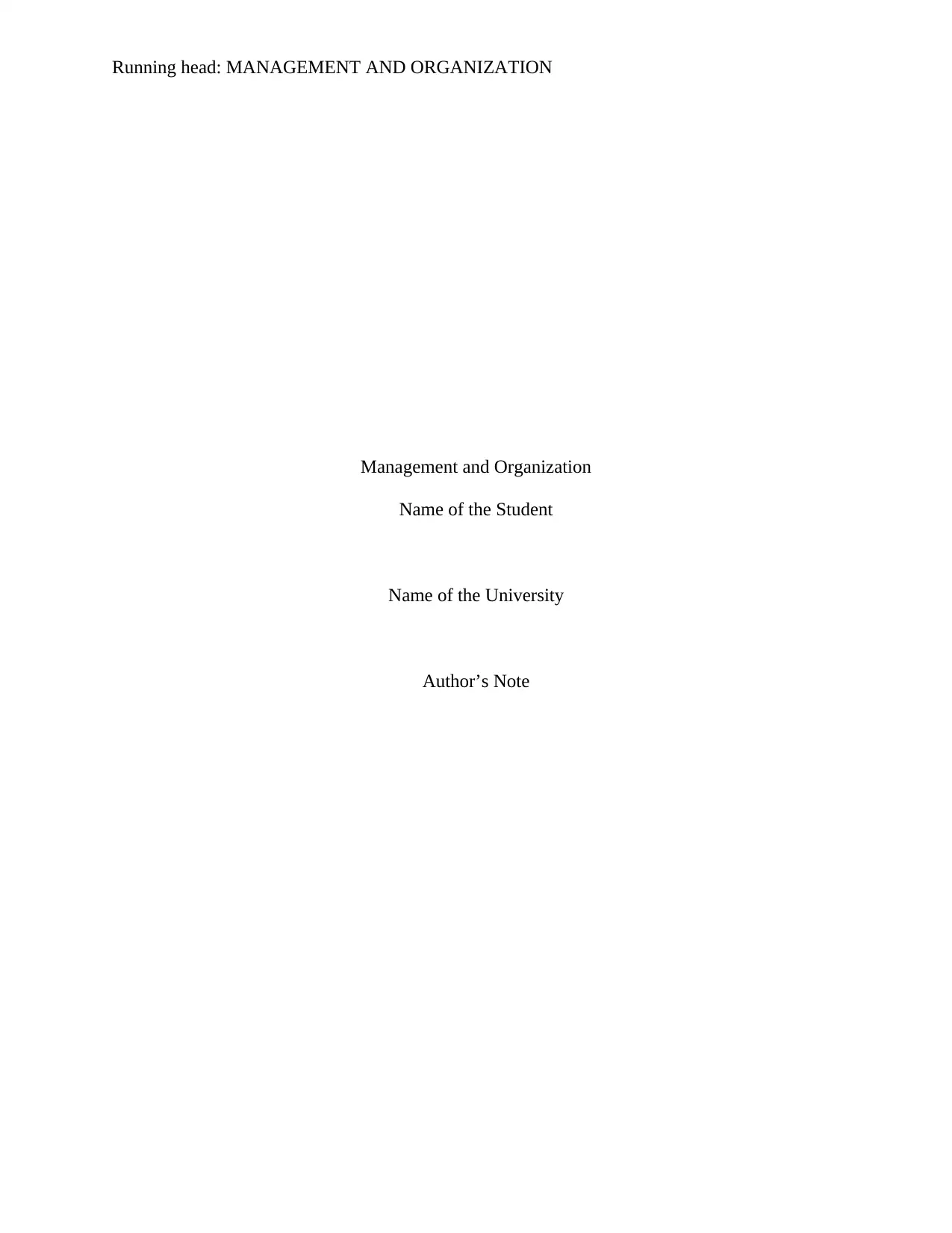
Running head: MANAGEMENT AND ORGANIZATION
Management and Organization
Name of the Student
Name of the University
Author’s Note
Management and Organization
Name of the Student
Name of the University
Author’s Note
Paraphrase This Document
Need a fresh take? Get an instant paraphrase of this document with our AI Paraphraser
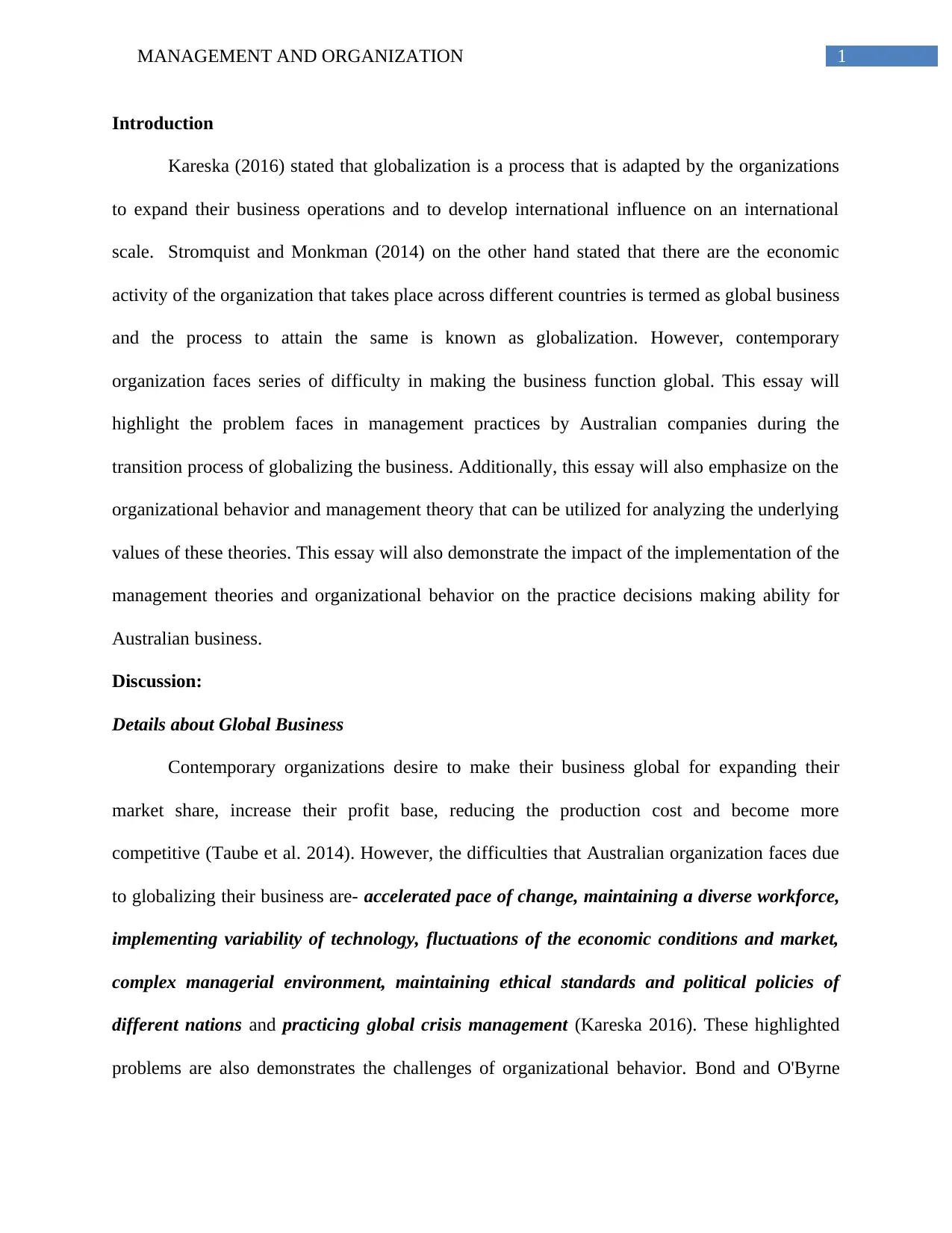
1MANAGEMENT AND ORGANIZATION
Introduction
Kareska (2016) stated that globalization is a process that is adapted by the organizations
to expand their business operations and to develop international influence on an international
scale. Stromquist and Monkman (2014) on the other hand stated that there are the economic
activity of the organization that takes place across different countries is termed as global business
and the process to attain the same is known as globalization. However, contemporary
organization faces series of difficulty in making the business function global. This essay will
highlight the problem faces in management practices by Australian companies during the
transition process of globalizing the business. Additionally, this essay will also emphasize on the
organizational behavior and management theory that can be utilized for analyzing the underlying
values of these theories. This essay will also demonstrate the impact of the implementation of the
management theories and organizational behavior on the practice decisions making ability for
Australian business.
Discussion:
Details about Global Business
Contemporary organizations desire to make their business global for expanding their
market share, increase their profit base, reducing the production cost and become more
competitive (Taube et al. 2014). However, the difficulties that Australian organization faces due
to globalizing their business are- accelerated pace of change, maintaining a diverse workforce,
implementing variability of technology, fluctuations of the economic conditions and market,
complex managerial environment, maintaining ethical standards and political policies of
different nations and practicing global crisis management (Kareska 2016). These highlighted
problems are also demonstrates the challenges of organizational behavior. Bond and O'Byrne
Introduction
Kareska (2016) stated that globalization is a process that is adapted by the organizations
to expand their business operations and to develop international influence on an international
scale. Stromquist and Monkman (2014) on the other hand stated that there are the economic
activity of the organization that takes place across different countries is termed as global business
and the process to attain the same is known as globalization. However, contemporary
organization faces series of difficulty in making the business function global. This essay will
highlight the problem faces in management practices by Australian companies during the
transition process of globalizing the business. Additionally, this essay will also emphasize on the
organizational behavior and management theory that can be utilized for analyzing the underlying
values of these theories. This essay will also demonstrate the impact of the implementation of the
management theories and organizational behavior on the practice decisions making ability for
Australian business.
Discussion:
Details about Global Business
Contemporary organizations desire to make their business global for expanding their
market share, increase their profit base, reducing the production cost and become more
competitive (Taube et al. 2014). However, the difficulties that Australian organization faces due
to globalizing their business are- accelerated pace of change, maintaining a diverse workforce,
implementing variability of technology, fluctuations of the economic conditions and market,
complex managerial environment, maintaining ethical standards and political policies of
different nations and practicing global crisis management (Kareska 2016). These highlighted
problems are also demonstrates the challenges of organizational behavior. Bond and O'Byrne
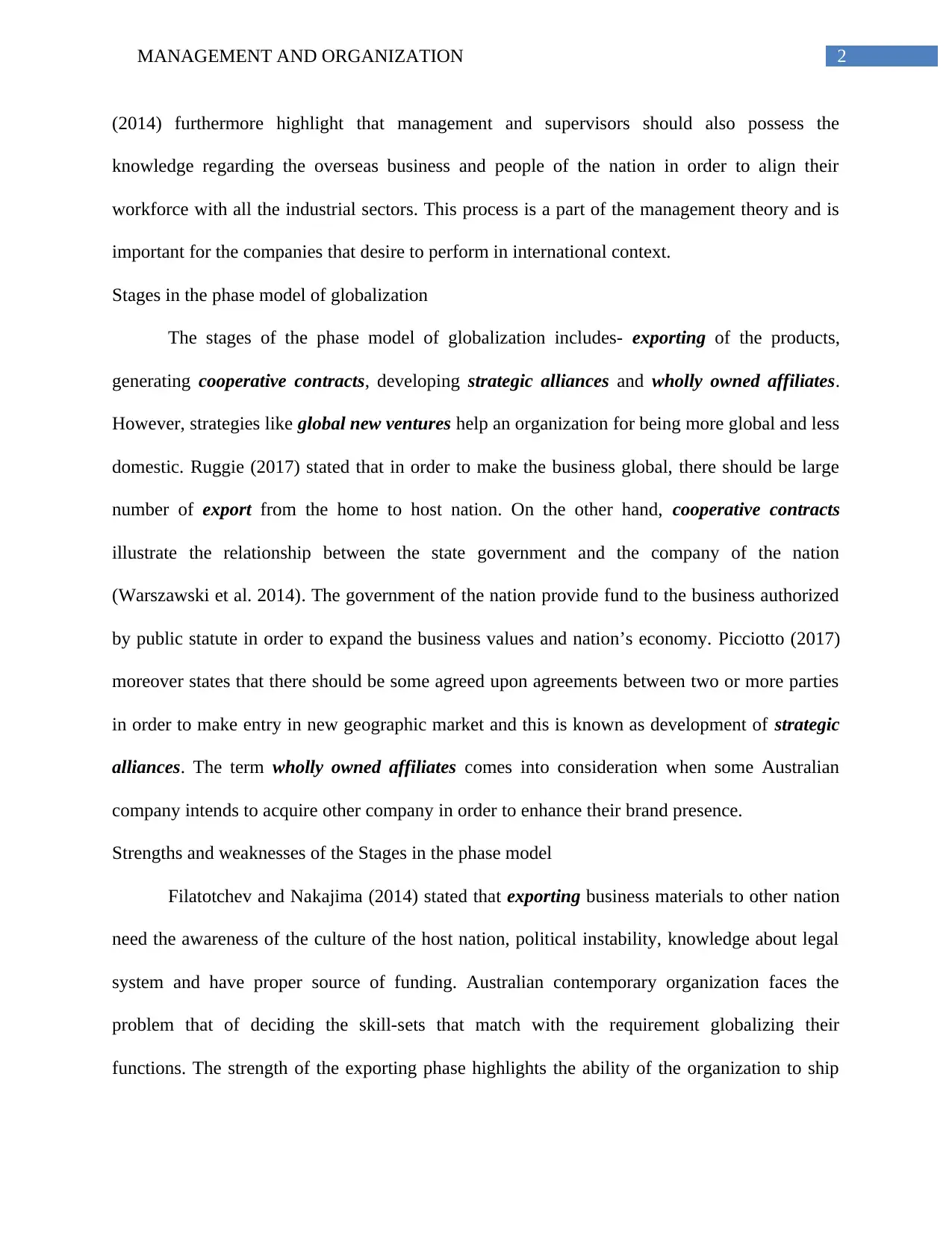
2MANAGEMENT AND ORGANIZATION
(2014) furthermore highlight that management and supervisors should also possess the
knowledge regarding the overseas business and people of the nation in order to align their
workforce with all the industrial sectors. This process is a part of the management theory and is
important for the companies that desire to perform in international context.
Stages in the phase model of globalization
The stages of the phase model of globalization includes- exporting of the products,
generating cooperative contracts, developing strategic alliances and wholly owned affiliates.
However, strategies like global new ventures help an organization for being more global and less
domestic. Ruggie (2017) stated that in order to make the business global, there should be large
number of export from the home to host nation. On the other hand, cooperative contracts
illustrate the relationship between the state government and the company of the nation
(Warszawski et al. 2014). The government of the nation provide fund to the business authorized
by public statute in order to expand the business values and nation’s economy. Picciotto (2017)
moreover states that there should be some agreed upon agreements between two or more parties
in order to make entry in new geographic market and this is known as development of strategic
alliances. The term wholly owned affiliates comes into consideration when some Australian
company intends to acquire other company in order to enhance their brand presence.
Strengths and weaknesses of the Stages in the phase model
Filatotchev and Nakajima (2014) stated that exporting business materials to other nation
need the awareness of the culture of the host nation, political instability, knowledge about legal
system and have proper source of funding. Australian contemporary organization faces the
problem that of deciding the skill-sets that match with the requirement globalizing their
functions. The strength of the exporting phase highlights the ability of the organization to ship
(2014) furthermore highlight that management and supervisors should also possess the
knowledge regarding the overseas business and people of the nation in order to align their
workforce with all the industrial sectors. This process is a part of the management theory and is
important for the companies that desire to perform in international context.
Stages in the phase model of globalization
The stages of the phase model of globalization includes- exporting of the products,
generating cooperative contracts, developing strategic alliances and wholly owned affiliates.
However, strategies like global new ventures help an organization for being more global and less
domestic. Ruggie (2017) stated that in order to make the business global, there should be large
number of export from the home to host nation. On the other hand, cooperative contracts
illustrate the relationship between the state government and the company of the nation
(Warszawski et al. 2014). The government of the nation provide fund to the business authorized
by public statute in order to expand the business values and nation’s economy. Picciotto (2017)
moreover states that there should be some agreed upon agreements between two or more parties
in order to make entry in new geographic market and this is known as development of strategic
alliances. The term wholly owned affiliates comes into consideration when some Australian
company intends to acquire other company in order to enhance their brand presence.
Strengths and weaknesses of the Stages in the phase model
Filatotchev and Nakajima (2014) stated that exporting business materials to other nation
need the awareness of the culture of the host nation, political instability, knowledge about legal
system and have proper source of funding. Australian contemporary organization faces the
problem that of deciding the skill-sets that match with the requirement globalizing their
functions. The strength of the exporting phase highlights the ability of the organization to ship
⊘ This is a preview!⊘
Do you want full access?
Subscribe today to unlock all pages.

Trusted by 1+ million students worldwide
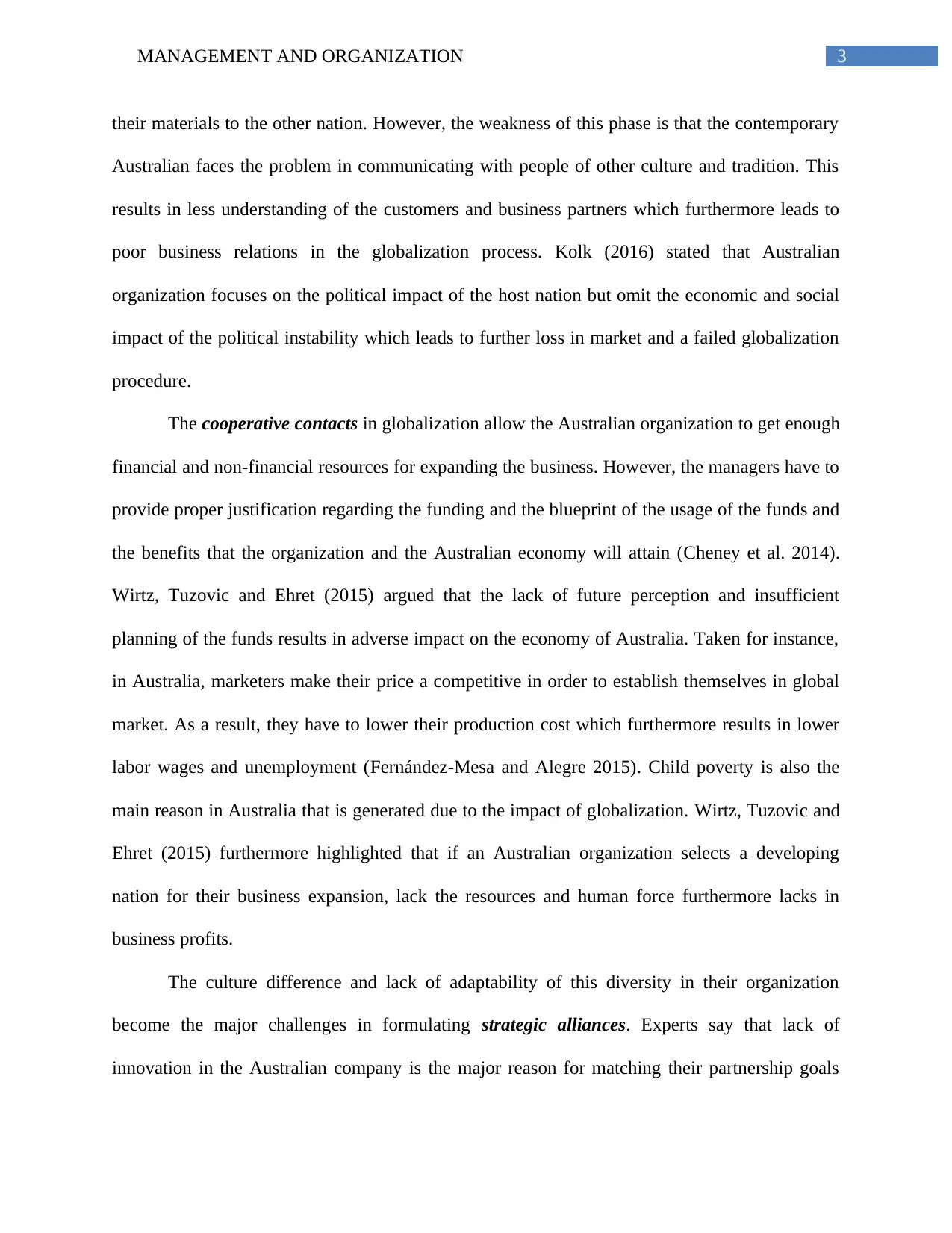
3MANAGEMENT AND ORGANIZATION
their materials to the other nation. However, the weakness of this phase is that the contemporary
Australian faces the problem in communicating with people of other culture and tradition. This
results in less understanding of the customers and business partners which furthermore leads to
poor business relations in the globalization process. Kolk (2016) stated that Australian
organization focuses on the political impact of the host nation but omit the economic and social
impact of the political instability which leads to further loss in market and a failed globalization
procedure.
The cooperative contacts in globalization allow the Australian organization to get enough
financial and non-financial resources for expanding the business. However, the managers have to
provide proper justification regarding the funding and the blueprint of the usage of the funds and
the benefits that the organization and the Australian economy will attain (Cheney et al. 2014).
Wirtz, Tuzovic and Ehret (2015) argued that the lack of future perception and insufficient
planning of the funds results in adverse impact on the economy of Australia. Taken for instance,
in Australia, marketers make their price a competitive in order to establish themselves in global
market. As a result, they have to lower their production cost which furthermore results in lower
labor wages and unemployment (Fernández-Mesa and Alegre 2015). Child poverty is also the
main reason in Australia that is generated due to the impact of globalization. Wirtz, Tuzovic and
Ehret (2015) furthermore highlighted that if an Australian organization selects a developing
nation for their business expansion, lack the resources and human force furthermore lacks in
business profits.
The culture difference and lack of adaptability of this diversity in their organization
become the major challenges in formulating strategic alliances. Experts say that lack of
innovation in the Australian company is the major reason for matching their partnership goals
their materials to the other nation. However, the weakness of this phase is that the contemporary
Australian faces the problem in communicating with people of other culture and tradition. This
results in less understanding of the customers and business partners which furthermore leads to
poor business relations in the globalization process. Kolk (2016) stated that Australian
organization focuses on the political impact of the host nation but omit the economic and social
impact of the political instability which leads to further loss in market and a failed globalization
procedure.
The cooperative contacts in globalization allow the Australian organization to get enough
financial and non-financial resources for expanding the business. However, the managers have to
provide proper justification regarding the funding and the blueprint of the usage of the funds and
the benefits that the organization and the Australian economy will attain (Cheney et al. 2014).
Wirtz, Tuzovic and Ehret (2015) argued that the lack of future perception and insufficient
planning of the funds results in adverse impact on the economy of Australia. Taken for instance,
in Australia, marketers make their price a competitive in order to establish themselves in global
market. As a result, they have to lower their production cost which furthermore results in lower
labor wages and unemployment (Fernández-Mesa and Alegre 2015). Child poverty is also the
main reason in Australia that is generated due to the impact of globalization. Wirtz, Tuzovic and
Ehret (2015) furthermore highlighted that if an Australian organization selects a developing
nation for their business expansion, lack the resources and human force furthermore lacks in
business profits.
The culture difference and lack of adaptability of this diversity in their organization
become the major challenges in formulating strategic alliances. Experts say that lack of
innovation in the Australian company is the major reason for matching their partnership goals
Paraphrase This Document
Need a fresh take? Get an instant paraphrase of this document with our AI Paraphraser
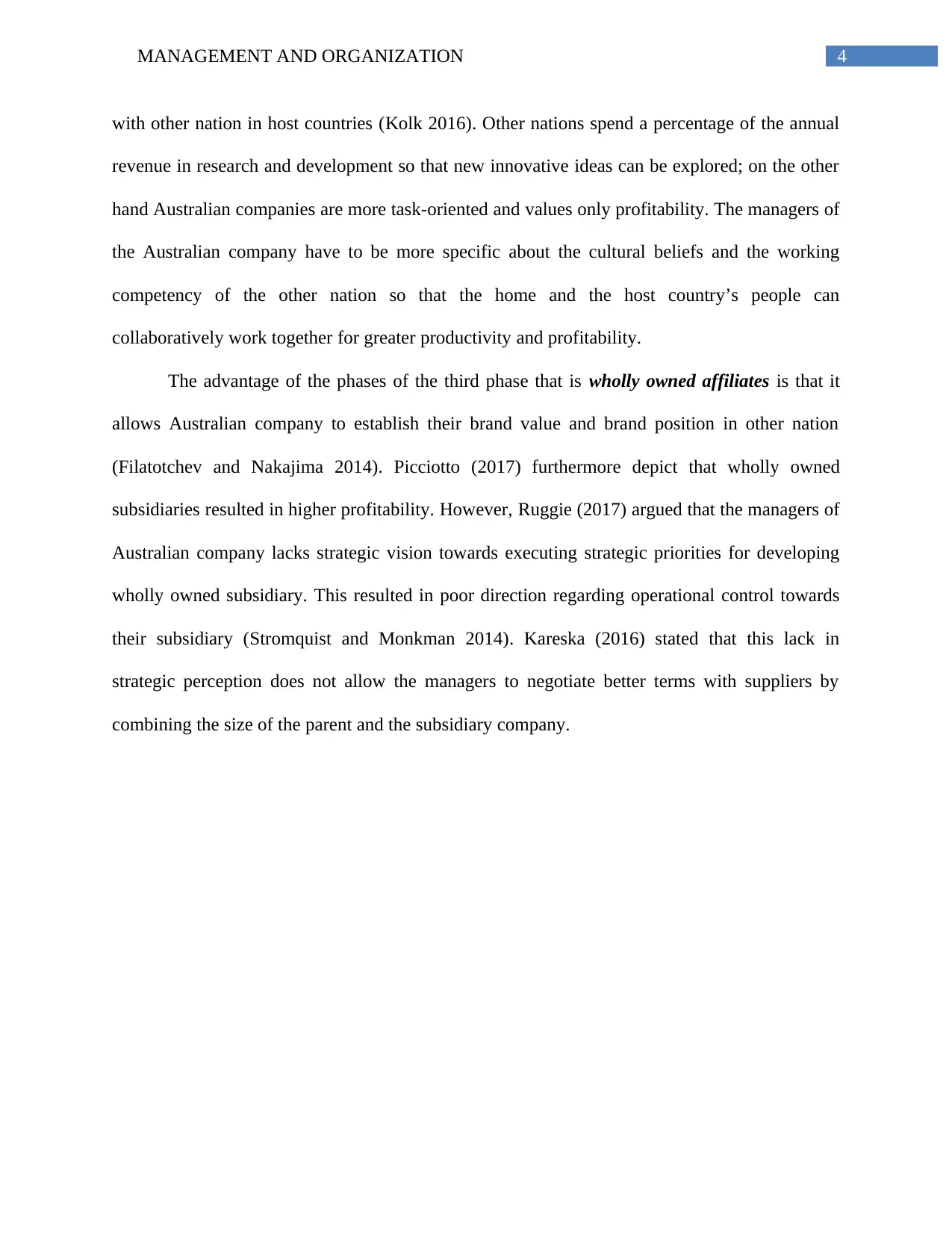
4MANAGEMENT AND ORGANIZATION
with other nation in host countries (Kolk 2016). Other nations spend a percentage of the annual
revenue in research and development so that new innovative ideas can be explored; on the other
hand Australian companies are more task-oriented and values only profitability. The managers of
the Australian company have to be more specific about the cultural beliefs and the working
competency of the other nation so that the home and the host country’s people can
collaboratively work together for greater productivity and profitability.
The advantage of the phases of the third phase that is wholly owned affiliates is that it
allows Australian company to establish their brand value and brand position in other nation
(Filatotchev and Nakajima 2014). Picciotto (2017) furthermore depict that wholly owned
subsidiaries resulted in higher profitability. However, Ruggie (2017) argued that the managers of
Australian company lacks strategic vision towards executing strategic priorities for developing
wholly owned subsidiary. This resulted in poor direction regarding operational control towards
their subsidiary (Stromquist and Monkman 2014). Kareska (2016) stated that this lack in
strategic perception does not allow the managers to negotiate better terms with suppliers by
combining the size of the parent and the subsidiary company.
with other nation in host countries (Kolk 2016). Other nations spend a percentage of the annual
revenue in research and development so that new innovative ideas can be explored; on the other
hand Australian companies are more task-oriented and values only profitability. The managers of
the Australian company have to be more specific about the cultural beliefs and the working
competency of the other nation so that the home and the host country’s people can
collaboratively work together for greater productivity and profitability.
The advantage of the phases of the third phase that is wholly owned affiliates is that it
allows Australian company to establish their brand value and brand position in other nation
(Filatotchev and Nakajima 2014). Picciotto (2017) furthermore depict that wholly owned
subsidiaries resulted in higher profitability. However, Ruggie (2017) argued that the managers of
Australian company lacks strategic vision towards executing strategic priorities for developing
wholly owned subsidiary. This resulted in poor direction regarding operational control towards
their subsidiary (Stromquist and Monkman 2014). Kareska (2016) stated that this lack in
strategic perception does not allow the managers to negotiate better terms with suppliers by
combining the size of the parent and the subsidiary company.
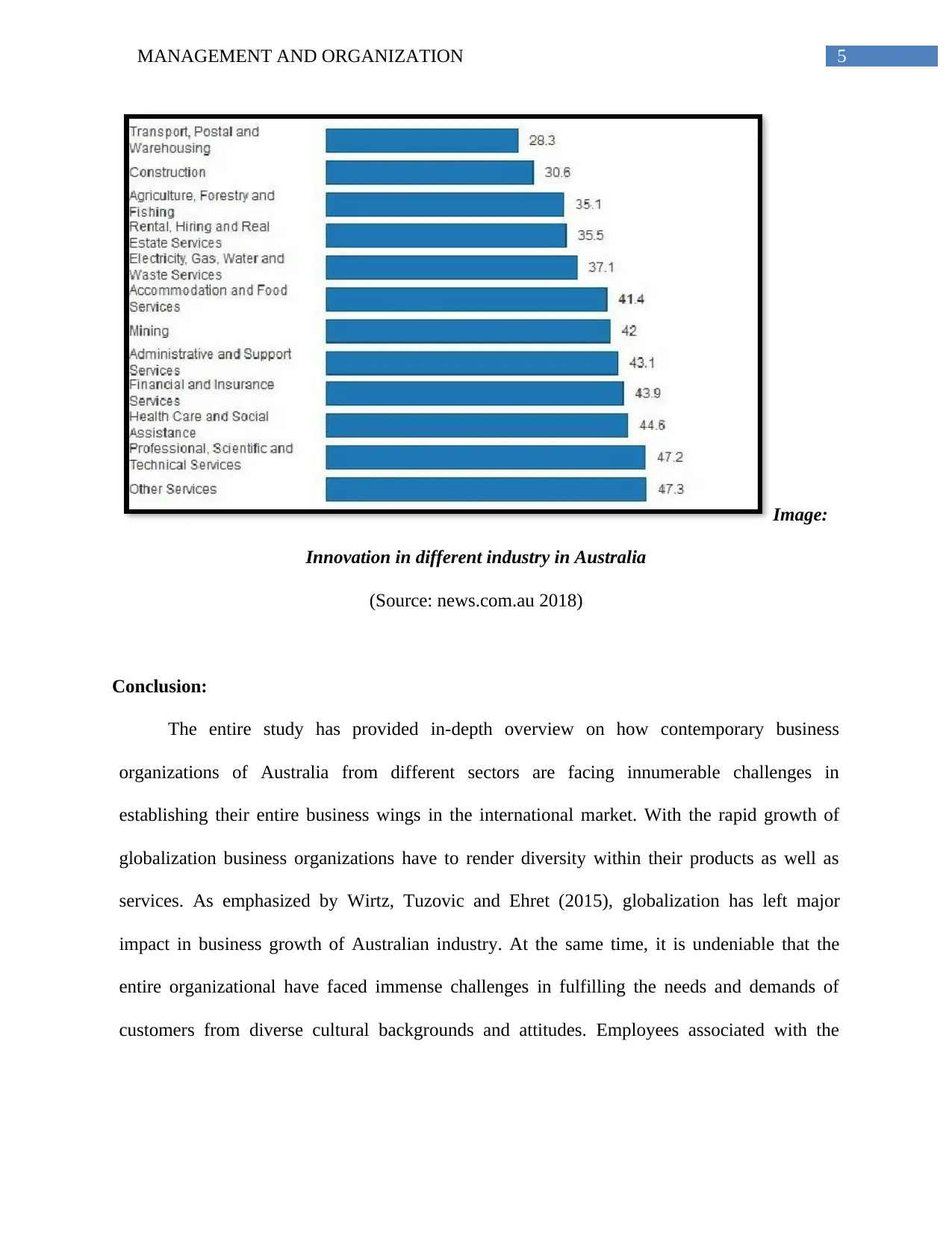
5MANAGEMENT AND ORGANIZATION
Image:
Innovation in different industry in Australia
(Source: news.com.au 2018)
Conclusion:
The entire study has provided in-depth overview on how contemporary business
organizations of Australia from different sectors are facing innumerable challenges in
establishing their entire business wings in the international market. With the rapid growth of
globalization business organizations have to render diversity within their products as well as
services. As emphasized by Wirtz, Tuzovic and Ehret (2015), globalization has left major
impact in business growth of Australian industry. At the same time, it is undeniable that the
entire organizational have faced immense challenges in fulfilling the needs and demands of
customers from diverse cultural backgrounds and attitudes. Employees associated with the
Image:
Innovation in different industry in Australia
(Source: news.com.au 2018)
Conclusion:
The entire study has provided in-depth overview on how contemporary business
organizations of Australia from different sectors are facing innumerable challenges in
establishing their entire business wings in the international market. With the rapid growth of
globalization business organizations have to render diversity within their products as well as
services. As emphasized by Wirtz, Tuzovic and Ehret (2015), globalization has left major
impact in business growth of Australian industry. At the same time, it is undeniable that the
entire organizational have faced immense challenges in fulfilling the needs and demands of
customers from diverse cultural backgrounds and attitudes. Employees associated with the
⊘ This is a preview!⊘
Do you want full access?
Subscribe today to unlock all pages.

Trusted by 1+ million students worldwide
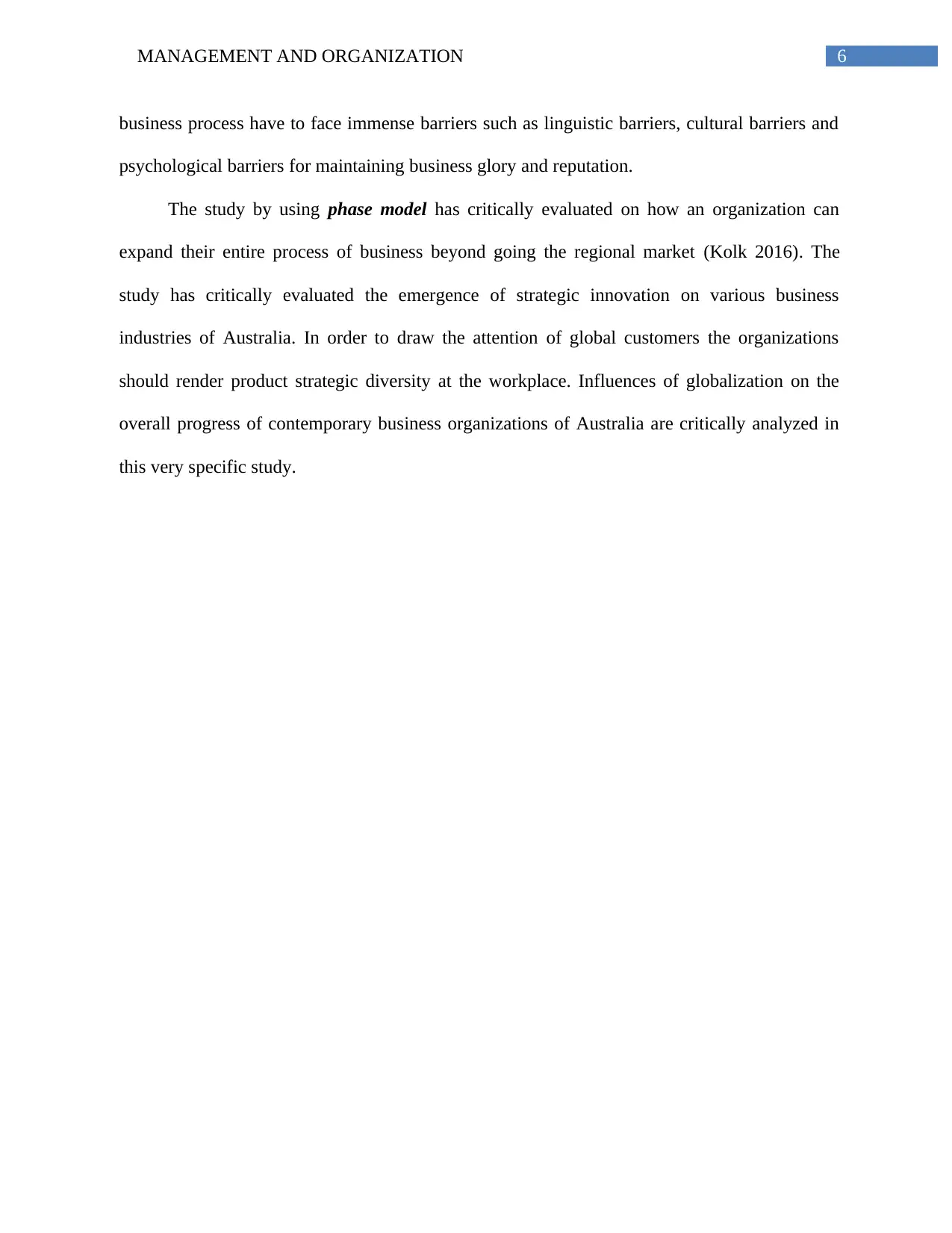
6MANAGEMENT AND ORGANIZATION
business process have to face immense barriers such as linguistic barriers, cultural barriers and
psychological barriers for maintaining business glory and reputation.
The study by using phase model has critically evaluated on how an organization can
expand their entire process of business beyond going the regional market (Kolk 2016). The
study has critically evaluated the emergence of strategic innovation on various business
industries of Australia. In order to draw the attention of global customers the organizations
should render product strategic diversity at the workplace. Influences of globalization on the
overall progress of contemporary business organizations of Australia are critically analyzed in
this very specific study.
business process have to face immense barriers such as linguistic barriers, cultural barriers and
psychological barriers for maintaining business glory and reputation.
The study by using phase model has critically evaluated on how an organization can
expand their entire process of business beyond going the regional market (Kolk 2016). The
study has critically evaluated the emergence of strategic innovation on various business
industries of Australia. In order to draw the attention of global customers the organizations
should render product strategic diversity at the workplace. Influences of globalization on the
overall progress of contemporary business organizations of Australia are critically analyzed in
this very specific study.
Paraphrase This Document
Need a fresh take? Get an instant paraphrase of this document with our AI Paraphraser
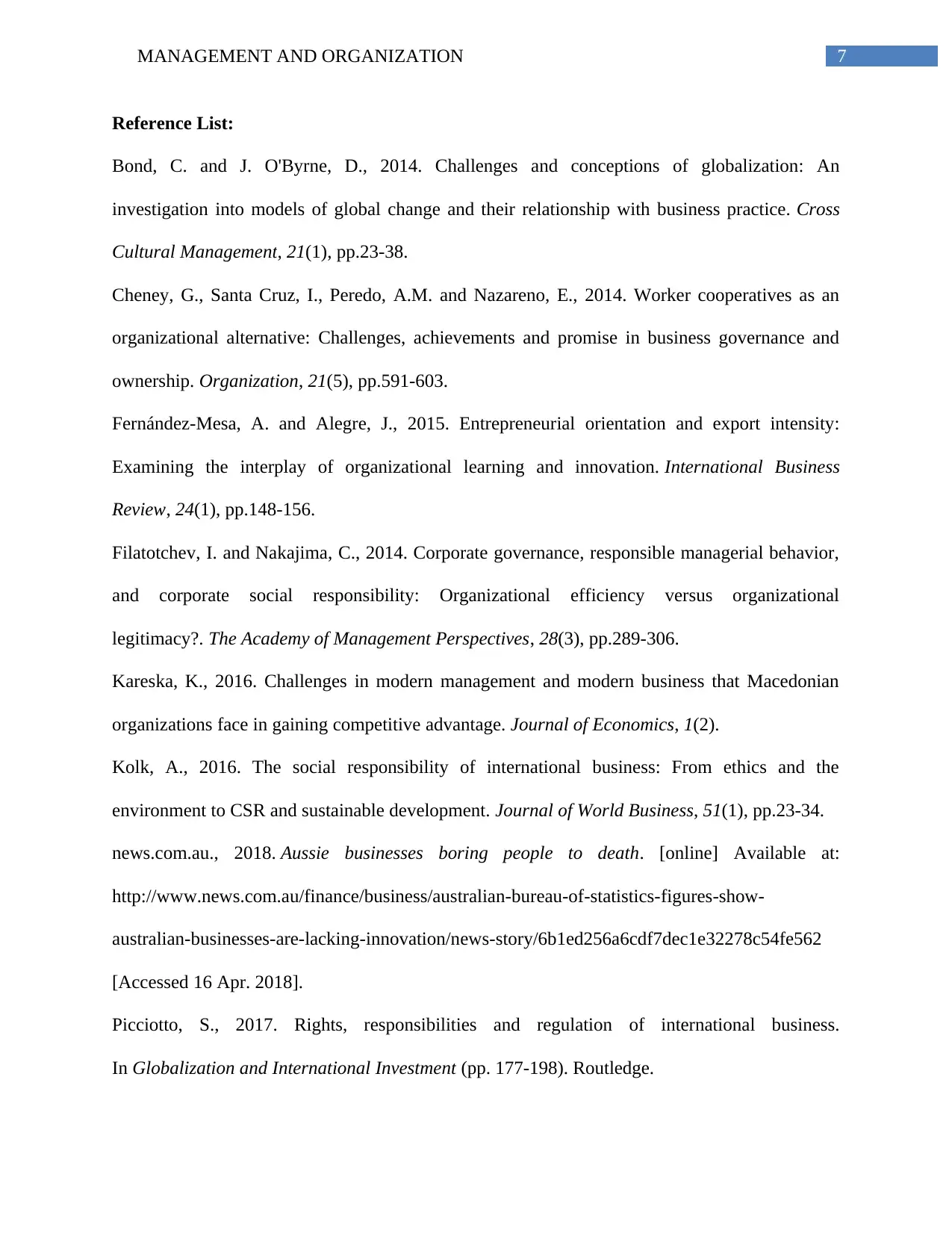
7MANAGEMENT AND ORGANIZATION
Reference List:
Bond, C. and J. O'Byrne, D., 2014. Challenges and conceptions of globalization: An
investigation into models of global change and their relationship with business practice. Cross
Cultural Management, 21(1), pp.23-38.
Cheney, G., Santa Cruz, I., Peredo, A.M. and Nazareno, E., 2014. Worker cooperatives as an
organizational alternative: Challenges, achievements and promise in business governance and
ownership. Organization, 21(5), pp.591-603.
Fernández-Mesa, A. and Alegre, J., 2015. Entrepreneurial orientation and export intensity:
Examining the interplay of organizational learning and innovation. International Business
Review, 24(1), pp.148-156.
Filatotchev, I. and Nakajima, C., 2014. Corporate governance, responsible managerial behavior,
and corporate social responsibility: Organizational efficiency versus organizational
legitimacy?. The Academy of Management Perspectives, 28(3), pp.289-306.
Kareska, K., 2016. Challenges in modern management and modern business that Macedonian
organizations face in gaining competitive advantage. Journal of Economics, 1(2).
Kolk, A., 2016. The social responsibility of international business: From ethics and the
environment to CSR and sustainable development. Journal of World Business, 51(1), pp.23-34.
news.com.au., 2018. Aussie businesses boring people to death. [online] Available at:
http://www.news.com.au/finance/business/australian-bureau-of-statistics-figures-show-
australian-businesses-are-lacking-innovation/news-story/6b1ed256a6cdf7dec1e32278c54fe562
[Accessed 16 Apr. 2018].
Picciotto, S., 2017. Rights, responsibilities and regulation of international business.
In Globalization and International Investment (pp. 177-198). Routledge.
Reference List:
Bond, C. and J. O'Byrne, D., 2014. Challenges and conceptions of globalization: An
investigation into models of global change and their relationship with business practice. Cross
Cultural Management, 21(1), pp.23-38.
Cheney, G., Santa Cruz, I., Peredo, A.M. and Nazareno, E., 2014. Worker cooperatives as an
organizational alternative: Challenges, achievements and promise in business governance and
ownership. Organization, 21(5), pp.591-603.
Fernández-Mesa, A. and Alegre, J., 2015. Entrepreneurial orientation and export intensity:
Examining the interplay of organizational learning and innovation. International Business
Review, 24(1), pp.148-156.
Filatotchev, I. and Nakajima, C., 2014. Corporate governance, responsible managerial behavior,
and corporate social responsibility: Organizational efficiency versus organizational
legitimacy?. The Academy of Management Perspectives, 28(3), pp.289-306.
Kareska, K., 2016. Challenges in modern management and modern business that Macedonian
organizations face in gaining competitive advantage. Journal of Economics, 1(2).
Kolk, A., 2016. The social responsibility of international business: From ethics and the
environment to CSR and sustainable development. Journal of World Business, 51(1), pp.23-34.
news.com.au., 2018. Aussie businesses boring people to death. [online] Available at:
http://www.news.com.au/finance/business/australian-bureau-of-statistics-figures-show-
australian-businesses-are-lacking-innovation/news-story/6b1ed256a6cdf7dec1e32278c54fe562
[Accessed 16 Apr. 2018].
Picciotto, S., 2017. Rights, responsibilities and regulation of international business.
In Globalization and International Investment (pp. 177-198). Routledge.
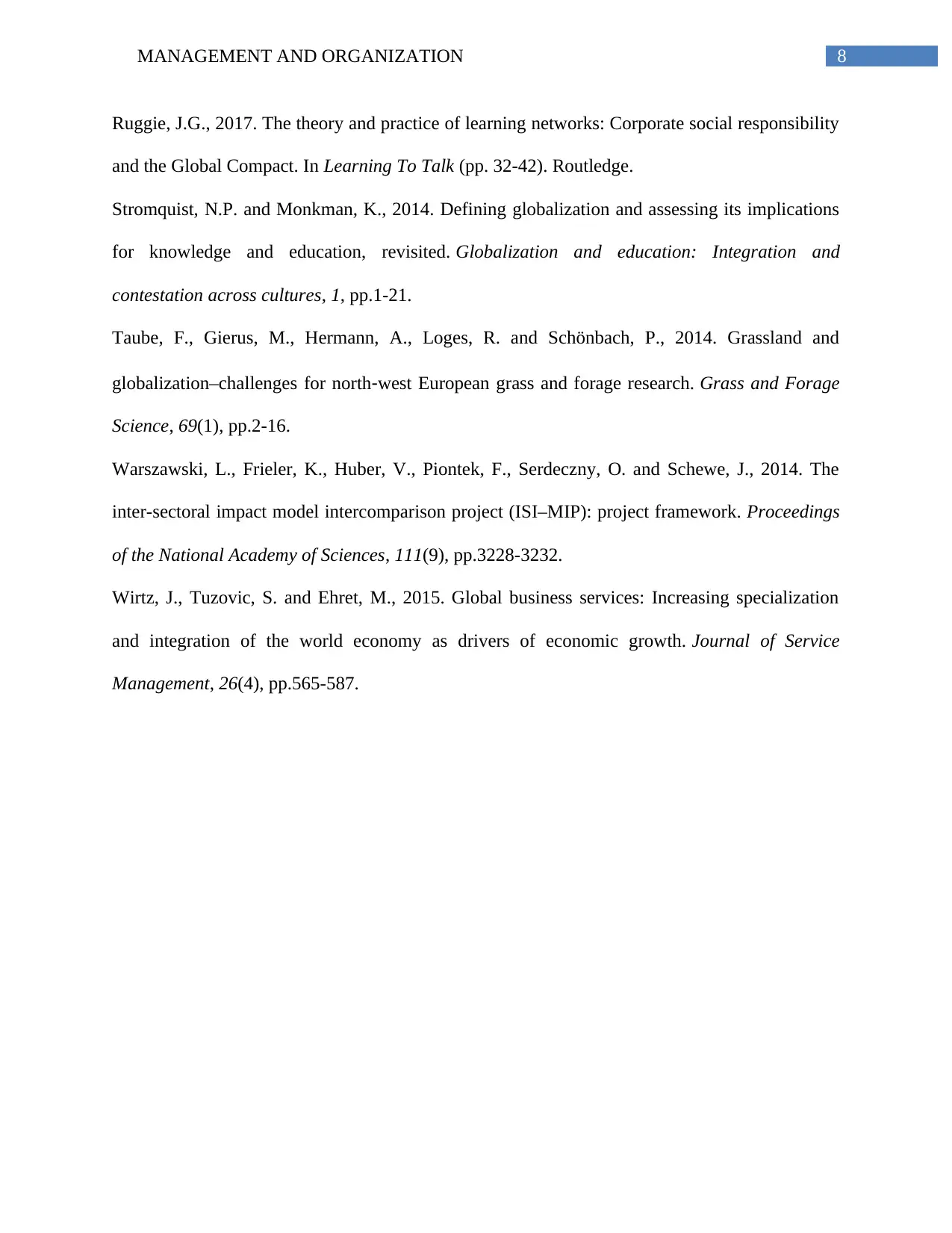
8MANAGEMENT AND ORGANIZATION
Ruggie, J.G., 2017. The theory and practice of learning networks: Corporate social responsibility
and the Global Compact. In Learning To Talk (pp. 32-42). Routledge.
Stromquist, N.P. and Monkman, K., 2014. Defining globalization and assessing its implications
for knowledge and education, revisited. Globalization and education: Integration and
contestation across cultures, 1, pp.1-21.
Taube, F., Gierus, M., Hermann, A., Loges, R. and Schönbach, P., 2014. Grassland and
globalization–challenges for north‐west European grass and forage research. Grass and Forage
Science, 69(1), pp.2-16.
Warszawski, L., Frieler, K., Huber, V., Piontek, F., Serdeczny, O. and Schewe, J., 2014. The
inter-sectoral impact model intercomparison project (ISI–MIP): project framework. Proceedings
of the National Academy of Sciences, 111(9), pp.3228-3232.
Wirtz, J., Tuzovic, S. and Ehret, M., 2015. Global business services: Increasing specialization
and integration of the world economy as drivers of economic growth. Journal of Service
Management, 26(4), pp.565-587.
Ruggie, J.G., 2017. The theory and practice of learning networks: Corporate social responsibility
and the Global Compact. In Learning To Talk (pp. 32-42). Routledge.
Stromquist, N.P. and Monkman, K., 2014. Defining globalization and assessing its implications
for knowledge and education, revisited. Globalization and education: Integration and
contestation across cultures, 1, pp.1-21.
Taube, F., Gierus, M., Hermann, A., Loges, R. and Schönbach, P., 2014. Grassland and
globalization–challenges for north‐west European grass and forage research. Grass and Forage
Science, 69(1), pp.2-16.
Warszawski, L., Frieler, K., Huber, V., Piontek, F., Serdeczny, O. and Schewe, J., 2014. The
inter-sectoral impact model intercomparison project (ISI–MIP): project framework. Proceedings
of the National Academy of Sciences, 111(9), pp.3228-3232.
Wirtz, J., Tuzovic, S. and Ehret, M., 2015. Global business services: Increasing specialization
and integration of the world economy as drivers of economic growth. Journal of Service
Management, 26(4), pp.565-587.
⊘ This is a preview!⊘
Do you want full access?
Subscribe today to unlock all pages.

Trusted by 1+ million students worldwide
1 out of 9
Related Documents
Your All-in-One AI-Powered Toolkit for Academic Success.
+13062052269
info@desklib.com
Available 24*7 on WhatsApp / Email
![[object Object]](/_next/static/media/star-bottom.7253800d.svg)
Unlock your academic potential
Copyright © 2020–2025 A2Z Services. All Rights Reserved. Developed and managed by ZUCOL.


